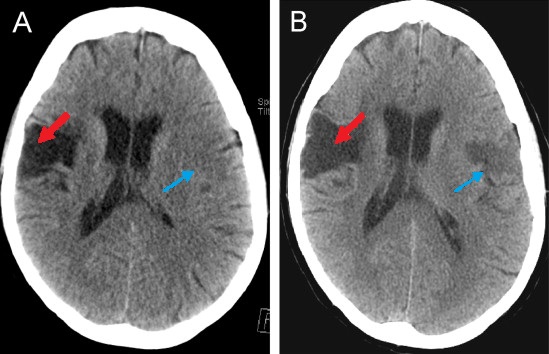Playlist
Show Playlist
Hide Playlist
Ischemic Stroke Syndromes
-
Slides 01 Stroke Neuropathology I.pdf
-
Reference List Pathology.pdf
-
Download Lecture Overview
00:01 Let’s take a look at Ischemic stroke syndromes. 00:03 Pure motor hemiplegia. Contralateral pons or internal capsule lacunar. 00:09 So in a vascular pathology, you're going to have these larger arteries that are affected, that’ll be the middle cerebral artery and the anterior cerebral artery, so on and so forth. 00:21 Or there's something called the lacunar infarct. 00:24 Say that your patient has had long term hypertension. 00:27 Remember we said that hypertension is extremely common risk for stroke taking place and if the hypertension is taking place over a long period of time you can only imagine that there is really no blood vessel that is left safe, right, so they're all vulnerable to some type of pathology. 00:45 And say that you have little blood vessels that are now undergoing compromise and undergoing damage and injury, and many times, patients with hypertension will have lacunar infarct but if that part of the brain is not significant in terms of proper functioning and then the patient may asymptomatic, but if it is an internal capsule that’s been affected such as a caudate, putamen, or even the thalamus or sub-thalamus; and then you will have motor type of issues and this would be a pure motor contralateral type of hemiplegia. 01:14 And then this would be a pure motor, contralateral type of hemiplegia. 01:19 Pure sensory stroke, contralateral thalamus on here, once again, the little blood vessels that may undergo strokes, a lacunar type of infarct. 01:28 Now, maybe it's a big blood vessel that has been affected our middle cerebral artery. 01:33 So think about that, please. 01:35 So this is an artery that's been affected and you know about your watershed areas, right? In my watershed, I'm referring to two blood vessels that are coming together. 01:43 And when they do, it's that particular tissue that is now susceptible to damage. 01:49 And so for example, middle cerebral artery enter cerebral artery would be an area in which you call that watershed. 01:56 And I told you earlier, middle cerebral artery would be supplying the lateral aspect of the parietal lobe responsible for sensations and activity in the upper extremity, maybe the head and neck. 02:08 Well, let's say that there is an MCA type of issue, and there is an atherosclerotic type of ischemic stroke taking place, then please understand that the hemiparesis will be taking place in the face, in the arm, much more so than the leg, right? Because of the homunculus, and the abrupt representation. 02:28 There might be aphasia, if it's the dominant side, sensory loss, might be hemianopsia, or eye deviation, if there's enough damage of your MCA taken place. 02:39 Anterior cerebral artery. What about this syndrome? Well, here think about the anterior cerebral artery pleased and you are supplying the medial aspect of your brain. 02:49 And so therefore, this then represents your legs and lower extremity. 02:53 The lower extremity weakness, sensory loss, Maybe even perhaps incontinence or limb apraxia. 03:00 What does that mean to you? You're not able to carry out those learned motor type of functioning. 03:06 Anterior cerebral artery. Where are you? The medial aspect of the brain. 03:12 What about the posterior cerebral artery? Well, the posterior cerebral artery, more or less think of it as being part of your occipital lobe, posteriorly. 03:21 You should be thinking about vision. 03:23 There might be contralateral homonymous hemianopsia. 03:26 There might be sensory loss as well. 03:28 Then you have the Posterior Inferior Cerebellar Artery. 03:32 Okay, so we're PICA. 03:34 And here, how's your patient going to present? "I'm going to present like this, Doc." So, you might have ataxia. 03:42 Horner syndrome, ipsilateral (loss of face of sensation), Contralateral (loss of body and sensation) if it's PICA. 03:49 This is referred to as being your Wallenberg syndrome.
About the Lecture
The lecture Ischemic Stroke Syndromes by Carlo Raj, MD is from the course Stroke (Cerebrovascular Accident).
Included Quiz Questions
Which type of ischemic stroke is seen with a lacunar infarct in the internal capsule?
- Pure motor hemiplegia on the contralateral side
- Anterior cerebral artery (ACA) syndrome on the ipsilateral side
- Middle cerebral artery (MCA) syndrome on the contralateral side
- Posterior cerebral artery (PCA) syndrome on the ipsilateral side
- Pure sensory hemiplegia on the ipsilateral side
What is the most common presentation in a patient with a posterior cerebral artery (PCA) infarct?
- Homonymous hemianopsia
- Dysphagia
- Right-sided hemiparesis
- Left-sided hemiparesis
- Acute loss of hearing
A patient presents with lower extremity weakness, sensory loss, limb apraxia, and incontinence. Where is the most likely site of the lesion?
- Anterior cerebral artery (ACA)
- Posterior inferior cerebellar artery (PICA)
- Anterior inferior cerebellar artery (AICA)
- Posterior cerebral artery (PCA)
- Superior cerebellar artery (SCA)
What is the typical presentation of a lacunar infarction in one side of the pons?
- Pure motor hemiplegia on the contralateral side
- Wallenberg syndrome
- Posterior inferior cerebellar artery (PICA) occlusion syndrome affecting the ipsilateral side
- Posterior cerebral artery (PCA) syndrome affecting the contralateral side
- Pure sensory stroke on the ipsilateral side
Customer reviews
5,0 of 5 stars
| 5 Stars |
|
1 |
| 4 Stars |
|
0 |
| 3 Stars |
|
0 |
| 2 Stars |
|
0 |
| 1 Star |
|
0 |
He is very clear and specific .Is important to know anatomy and pathology to understand his lecure an be able to respond thearlier questions




